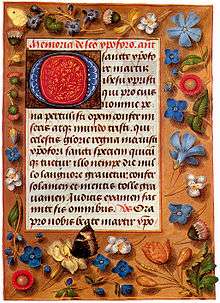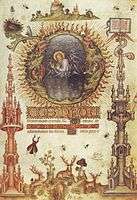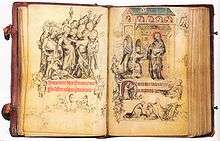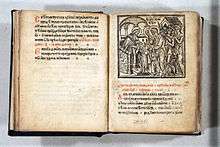Book of hours

.jpg)
An early 15th century French Book of Hours, open to an illustration of the 'Adoration of the Magi' (MS13, Society of Antiquaries of London, bequeathed to the Society in 1769 by the Revd Charles Lyttelton, Bishop of Carlisle and President of the Society (1754-8).

The book of hours is a Christian devotional book popular in the Middle Ages. It is the most common type of surviving medieval illuminated manuscript. Like every manuscript, each manuscript book of hours is unique in one way or another, but most contain a similar collection of texts, prayers and psalms, often with appropriate decorations, for Christian devotion. Illumination or decoration is minimal in many examples, often restricted to decorated capital letters at the start of psalms and other prayers, but books made for wealthy patrons may be extremely lavish, with full-page miniatures.
Books of hours were usually written in Latin (the Latin name for them is horae), although there are many entirely or partially written in vernacular European languages, especially Dutch. The English term primer is usually now reserved for those books written in English. Tens of thousands of books of hours have survived to the present day, in libraries and private collections throughout the world.
The typical book of hours is an abbreviated form of the breviary which contained the Divine Office recited in monasteries. It was developed for lay people who wished to incorporate elements of monasticism into their devotional life. Reciting the hours typically centered upon the reading of a number of psalms and other prayers. A typical book of hours contains:
- A Calendar of Church feasts
- An excerpt from each of the four gospels
- The Little Office of the Blessed Virgin Mary
- The fifteen Psalms of Degrees
- The seven Penitential Psalms
- A Litany of Saints
- An Office for the Dead
- The Hours of the Cross[2]
- Various other prayers
Most 15th-century books of hours have these basic contents. The Marian prayers Obsecro te ("I beseech thee") and O Intemerata ("O undefiled one") were frequently added, as were devotions for use at Mass, and meditations on the Passion of Christ, among other optional texts.
History

The book of hours has its ultimate origin in the Psalter, which monks and nuns were required to recite. By the 12th century this had developed into the breviary, with weekly cycles of psalms, prayers, hymns, antiphons, and readings which changed with the liturgical season.[3] Eventually a selection of texts was produced in much shorter volumes and came to be called a book of hours.[4]
Many books of hours were made for women. There is some evidence that they were sometimes given as a wedding present from a husband to his bride.[5] Frequently they were passed down through the family, as recorded in wills.[5]
Although the most heavily illuminated books of hours were enormously expensive, a small book with little or no illumination was affordable much more widely, and increasingly so during the 15th century. The earliest surviving English example was apparently written for a laywoman living in or near Oxford in about 1240. It is smaller than a modern paperback but heavily illuminated with major initials, but no full-page miniatures. By the 15th century, there are also examples of servants owning their own Books of Hours. In a court case from 1500, a pauper woman is accused of stealing a domestic servant's prayerbook.[6]
Very rarely the books included prayers specifically composed for their owners, but more often the texts are adapted to their tastes or sex, including the inclusion of their names in prayers. Some include images depicting their owners, and some their coats of arms. These, together with the choice of saints commemorated in the calendar and suffrages, are the main clues for the identity of the first owner. By at least the 15th century, the Netherlands and Paris workshops were producing books of hours for stock or distribution, rather than waiting for individual commissions. These were sometimes with spaces left for the addition of personalized elements such as local feasts or heraldry.
By the end of the 15th century, the advance of printing made books more affordable and much of the emerging middle-class could afford to buy a printed book of hours, and new manuscripts were only commissioned by the very wealthy. The Kitab salat al-sawai (1514), widely considered the first book in Arabic printed using moveable type, is a book of hours intended for Arabic-speaking Christians and presumably commissioned by Pope Julius II.[7]
Decorations

As many books of hours are richly illuminated, they form an important record of life in the 15th and 16th centuries as well as the iconography of medieval Christianity. Some of them were also decorated with jewelled covers, portraits, and heraldic emblems. Some were bound as girdle books for easy carrying, though few of these or other medieval bindings have survived. Luxury books, like the Talbot Hours of John Talbot, 1st Earl of Shrewsbury, may include a portrait of the owner, and in this case his wife, kneeling in adoration of the Virgin and Child as a form of donor portrait. In expensive books, miniature cycles showed the Life of the Virgin or the Passion of Christ in eight scenes decorating the eight Hours of the Virgin, and the Labours of the Months and signs of the zodiac decorating the calendar. Secular scenes of calendar cycles include many of the best known images from books of hours, and played an important role in the early history of landscape painting.
From the 14th century decorated borders round the edges of at least important pages were common in heavily illuminated books, including books of hours. At the beginning of the 15th century these were still usually based on foliage designs, and painted on a plain background, but by the second half of the century coloured or patterned backgrounds with images of all sorts of objects, were used in luxury books.
Second-hand books of hours were often modified for new owners, even among royalty. After defeating Richard III, Henry VII gave Richard's book of hours to his mother, who modified it to include her name. Heraldry was usually erased or over-painted by new owners. Many have handwritten annotations, personal additions and marginal notes but some new owners also commissioned new craftsmen to include more illustrations or texts. Sir Thomas Lewkenor of Trotton hired an illustrator to add details to what is now known as the Lewkenor Hours. Flyleaves of some surviving books include notes of household accounting or records of births and deaths, in the manner of later family bibles. Some owners had also collected autographs of notable visitors to their house. Books of hours were often the only book in a house, and were commonly used to teach children to read, sometimes having a page with the alphabet to assist this.
Towards the end of the 15th century, printers produced books of hours with woodcut illustrations, and the book of hours was one of the main works decorated in the related metalcut technique.
The luxury book of hours

(Among the plants are the Veronica, Vinca, Viola tricolor, Bellis perennis, and Chelidonium majus. The butterfly is Aglais urticae. The Latin text is a devotion to Saint Christopher).
In the 14th century the book of hours overtook the psalter as the most common vehicle for lavish illumination. This partly reflected the increasing dominance of illumination both commissioned and executed by laymen rather than monastic clergy. From the late 14th century a number of bibliophile royal figures began to collect luxury illuminated manuscripts for their decorations, a fashion that spread across Europe from the Valois courts of France and the Burgundy, as well as Prague under Charles IV, Holy Roman Emperor and later Wenceslaus. A generation later, Duke Philip the Good of Burgundy was the most important collector of manuscripts, with several of his circle also collecting.[8] It was during this period that the Flemish cities overtook Paris as the leading force in illumination, a position they retained until the terminal decline of the illuminated manuscript in the early 16th century.
The most famous collector of all, the French prince John, Duke of Berry (1340–1416) owned several books of hours, some of which survive, including the most celebrated of all, the Très Riches Heures du Duc de Berry. This was begun around 1410 by the Limbourg brothers, although left incomplete by them, and decoration continued over several decades by other artists and owners. The same was true of the Turin-Milan Hours, which also passed through Berry's ownership.
By the mid-15th century, a much wider group of nobility and rich businesspeople were able to commission highly decorated, often small, books of hours. With the arrival of printing, the market contracted sharply, and by 1500 the finest quality books were once again being produced only for royal or very grand collectors. One of the last major illuminated book of hours was the Farnese Hours completed for the Roman Cardinal Alessandro Farnese in 1546 by Giulio Clovio, who was also the last major manuscript illuminator.
Gallery
 The Visconti Hours
The Visconti Hours Calendar page from the Hours of Catherine of Cleves for June 1–15.
Calendar page from the Hours of Catherine of Cleves for June 1–15. Book of Hours of Jeanne d'Evreux: Arrest of Jesus and Annunciation
Book of Hours of Jeanne d'Evreux: Arrest of Jesus and Annunciation_-_Simon_de_Varie_Kneeling_in_Prayer_-_Google_Art_Project.jpg) Book of hours of Simone de Varie, portrait of the owner and his wife
Book of hours of Simone de Varie, portrait of the owner and his wife Book of Hours, British Library, the Arrest of Christ
Book of Hours, British Library, the Arrest of Christ Scenes from the Life of Christ and Life of the Virgin in the same book
Scenes from the Life of Christ and Life of the Virgin in the same book Les Très Riches Heures
Les Très Riches Heures
du duc de Berry
A Funeral Service.jpg) Bedford Hours; building the Tower of Babel
Bedford Hours; building the Tower of Babel

 The Annunciation, 1440–45
The Annunciation, 1440–45 Printed Bulgarian book of hours, 1566
Printed Bulgarian book of hours, 1566%2C_f.27r_-_BL_Add_MS_24098.jpg)
_St._Peter%2C_holding_a_key_and_a_book.jpg) Llanbeblig Hours. St. Peter, holding a key and a book
Llanbeblig Hours. St. Peter, holding a key and a book
Selected examples
See Category:Illuminated books of hours for a fuller list
In Europe
- Book of Hours, 'The De Brailes Hours' (formerly known as 'The Dyson Perrins Hours'), 1240, British Library, Add. MS 49999
- Howard Psalter and Hours, 1310-1320, British Library, MS Arundel 83, pt 1
- Sforza Hours: London, British Library, Add. Ms. 34294
- Bedford Hours: London, British Library, Add. Ms. 18850
- Très Riches Heures du Duc de Berry, around 1411-1416: Musée Condé, Chantilly (France), Ms. 65
- Turin-Milan Hours: Turin City Museum of Ancient Art, Ms. Inv. 47
- Tres belles heures du Duc de Berry: Brussels, Royal Library of Belgium, 11060-11061
- Petites heures du Duc de Berry: Paris, Royal Library, lat. 18014
- Les très belles heures de Notre-Dame du Duc de Berry: Paris, Bibliothèque nationale, nouv. acq. lat. 3093
- Hours of Gian Galeazzo Visconti, Biblioteca Nazionale in Florence.
- Rohan Hours, 1430s, BnF
- Taymouth Hours
- Hours of Étienne Chevalier, 1450s - sheets in several libraries
- Black Hours of Galeazzo Maria Sforza, c. 1460, Austrian National Library in Vienna
- Grandes Heures of Anne of Brittany, BnF
- Rothschild Prayerbook, c. 1500-1520; Austrian National Library in Vienna
- Hours of James IV of Scotland, c. 1503, Austrian National Library
- Primer of Claude of France, 1505, Cambridge, Fitzwilliam Museum, Ms. 294 - simplified for a young princess
- Book of Hours (Milan, Biblioteca Trivulziana, Cod. 470)
- Hours of Gian Galeazzo Visconti
- Llanbeblig Book of Hours, 1390-1400; National Library of Wales, NLW MS 17520A
In the United States
- Belles Heures of Jean de France, Duc de Berry, miniatures of 'the Limburg Brothers': New York, The Metropolitan Museum of Art, The Cloisters
- Black Hours, Morgan Library, New York, The Morgan Library & Museum, Ms. 493
- Hours of Catherine of Cleves, 15th century (property of 'Katharina van Kleef'): New York, The Morgan Library & Museum
- Hours of Jeanne d'Evreux, 1325-1328: New York, The Metropolitan Museum of Art, The Cloisters
- Hours of Henry VIII, with miniatures by Jean Poyer: New York, The Morgan Library & Museum
- Farnese Hours, 1546, illuminated by Giulio Clovio, Morgan Library in New York
See also
| Wikimedia Commons has media related to Books of Hours. |
Notes
- ↑ Plummer, plates 1-2
- ↑ Danish Royal Library Archived December 24, 2008, at the Wayback Machine.
- ↑ Eamon Duffy, "A Very Personal Possession: Eamon Duffy Tells How a Careful Study of Surviving Books of Hours Can Tell Us Much About the Spiritual and Temporal Life of Their Owners and Much More Besides." History Today 56.11 (Nov 2006): 12(7).
- ↑ John Harthan "The Book of Hours: With a Historical Survey and Commentary by John Harthan.: New York: Crowell, 1977.
- 1 2 John Harthan
- ↑ Eamon Duffy
- ↑ M. Krek, M. (1979). "The Enigma of the First Arabic Book Printed from Movable Type". Journal of Near Eastern Studies. 38 (3): 203–212. doi:10.1086/372742.
- ↑ Thomas, 8-9
References
- The Oxford Dictionary of Art ISBN 0-19-280022-1
- Duffy, Eamon, The Stripping of the Altars: Traditional Religion in England 1400-1580 (Yale, 1992) ISBN 0-300-06076-9
- Eamon Duffy - A Very Personal Possession (History Today November 2006)
- John Harthan - The Book of Hours: With a Historical Survey and Commentary by John Harthan. New York: Crowell, 1977.
- Plummer, John, The Hours of Catherine of Cleves, New York, George Braziller, 1966
- Thomas, Marcel; The Golden Age; Manuscript Painting at the Time of Jean, Duc de Berry, 1979, Chatto & Windus, ISBN 0701124725
Further reading
- Ashley, K.M. (2002) Creating Family Identity in Books of Hours. Journal of Medieval and Early Modern Studies, (1) 145-165.
- Calkins, Robert G. Illuminated Books of the Middle Ages. Ithaca, New York: Cornell University Press, 1983. ISBN 9780801415067
- Dückers, Rob, and Pieter Roelofs. The Limbourg Brothers - Nijmegen Masters at the French Court 1400-1416. Ghent: Ludion, 2005. ISBN 9789055445776
- Duffy, Eamon. Marking the Hours: English People and their Prayers 1240 - 1570. New Haven: Yale University Press, 2006. ISBN 0-300-11714-0
- Pächt, Otto. Book Illumination in the Middle Ages (translation, Kay Davenport), London: Harvey Miller Publishers, 1986. ISBN 0-19-921060-8
- Simmons, Eleanor. Les Heures de Nuremberg, Les Editions du Cerf, Paris, 1994. ISBN 2-204-04841-0
- Wieck, Roger S. Painted Prayers: The Book of Hours in Medieval and Renaissance Art, New York: George Braziller, 2004. ISBN 978-0-8076-1457-0
- Wieck, Roger S. Time Sanctified: The Book of Hours in Medieval Art and Life, New York: George Braziller, 1988. ISBN 978-0807614983
- For individual works
- The Hours of Mary of Burgundy (facsimile edition). Harvey Miller, 1995. ISBN 1-872501-87-7
- Barstow, Kurt. The Gualenghi-d'Este Hours: Art and Devotion in Renaissance Ferrara. Los Angeles: Getty Publications, 2000. ISBN 978-0-89236-370-4
- Clark, Gregory T. The Spitz Master: A Parisian Book of Hours. Los Angeles: Getty Publications, 2003. ISBN 9780892367122
- Meiss, Millard, and Edith W. Kirsch. The Visconti Hours. New York: George Braziller, 1972. ISBN 9780807613597
- Meiss, Millard, and Elizabeth H. Beatson. The Belles Heures of Jean, Duke of Berry. New York: George Braziller, 1974. ISBN 978-0807607503
- Meiss, Millard, and Marcel Thomas. The Rohan Master: A Book of Hours (translation, Katharine W. Carson). New York: George Braziller, 1973. ISBN 978-0807613580
- Porcher, Jean. The Rohan Book of Hours: With an Introduction and Notes by Jean Porcher. New York: Thomas Yoseloff, 1959.
External links
- General information:
- Book of Hours - Harry Ransom Center of the University of Texas at Austin
- World Digital Library from partner - Library of Congress (Digital Books of Hours)
- "A Masterpiece Reconstructed: The Hours of Louis XII". Prints & Books. Victoria and Albert Museum. Retrieved 2009-11-28.
- Sacred Image and Illusion in Late Flemish Manuscripts, Robert G. Calkins, Cornell University
- Abebooks, Collecting Books of Hours with a varied selection of examples.
- 541 examples from the Digital Scriptorium
- Book of Hours Tutorial, Les Enluminures and The Pierpont Morgan Library, MS M.1093
- Blog: PECIA/ Le manuscrit médiéval ~ The medieval manuscript
- Prints & People: A Social History of Printed Pictures, an exhibition catalog from The Metropolitan Museum of Art (fully available online as PDF)
- Full "turn the pages" online individual manuscripts:
- Lavishly illustrated Books of Hours, 12th through 16th centuries, Center for Digital Initiatives, University of Vermont Libraries
- The Sforza Hours at the British Library.
- Book of Hours, Use of Rome (the 'Golf Book'), c.1540, BL, Add MS 24098.
- Catholic Church. Book of hours Ms.Library of Congress. Rosenwald ms. 10, 1524. 113 leaves (23 lines (calendar 33 lines)), bound: parchment, col. ill.; 24 cm.
- Picturing Prayer, Books of Hours at Houghton Library, Harvard University.
- Book of Hours, of Premonstratensian Use at the Digital Archives Initiative Memorial University of Newfoundland.
- Late 15th Century French Book of Hours- De Villers Book of Hours, Digitized Collection: Utah State University.
- The texts:
- A Hypertext Book of Hours; full texts and translation
- Late Medieval and Renaissance Illuminated Manuscripts - Books of Hours 1400-1530 - An excellent guide containing tables describing all the various uses; also with original Latin texts and high-resolution photographs of many books.
- Books of Hours at the University of Pennsylvania Libraries - fully digitized with descriptions.
